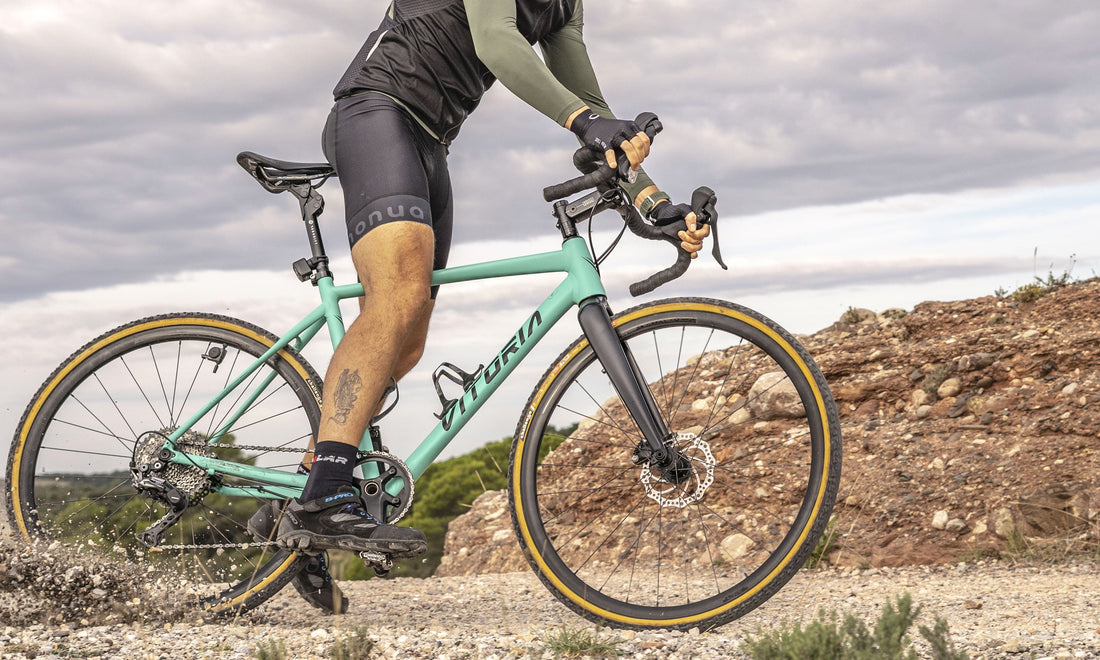
How to Convert Road Bike to Gravel Bike: Your Ultimate Guide
Gravel riding is an increasingly popular form of cycling that has captured the attention of both road cyclists and mountain bikers. While there are bikes specially designed for gravel riding, if you are willing to get hands-on there are some easy things you can do to convert your standard road bike to a gravel worthy configuration. In this post we will run through a basic overview of the things you need to think about while converting your road bike to a gravel bike. Here are the general areas that you will need to think about when doing a road bike to gravel bike conversion:
-
Install the widest tires you can: One of the easiest and most important modifications you need to make to a road bike to make it suitable for gravel riding is to install the widest tires that will fit your frame. Gravel bike tires are designed to deal with loose and unstable terrain and provide good traction on a variety of surfaces.
-
Change your gearing: Adjusting the gear ratio on your bike by swapping out your cassette and front chain ring can really help depending on the type of terrain you will be riding. Most gravel bikes use a more mountain bike style gearing with a very wide cassette and a relatively small front chain ring to optimize for climbing while still allowing for a relatively low gear for flats.
-
Swap handlebars: Another important modification you can make is to swap out your road handlebars for a gravel specific handlebar. Gravel bike handlebars are generally wider than road bars and they often include flared drops. Some bars even provide rise which puts the rider in a more upright position which can be helpful when gravel riding. Gravel bars provide a more comfortable and more stable riding position on rough terrain.
-
Add gravel specific accessories: You may also want to add accessories to your road bike to make it more suitable for gravel riding. This might include one or more bags like a top tube bag or handlebar bar or a frame bag where you can carry food, spare tubes, tools, etc. Fenders are another great accessory that can keep the mud off your back and keep you dry.
-
Adjust your fit: You will likely want to adjust your fit to make sure the bike is set up for gravel riding. Oftentimes gravel bikes are set up with a more upright riding position which can be accomplished by adding rise to the front end through stem angle, extra spacers, a shortened stem, or even a handlebar swap. You might also end up adjusting the saddle height and position if you change anything on the front end.
- Add comfort: You can add some additional comfort to your stiff road frame by installing a suspension seatpost or suspension stem to smooth out the buzz of gravel roads and trails.
Gravel Tire Conversion
One of the most basic parts of any road bike to gravel bike conversion is swapping out your existing road tires for gravel tires. Gravel specific tires are wider than road tires and have more aggressive tread patterns so they can provide good traction on rough terrain. Here are some tips:
- Determine the maximum tire width you can fit in your frame: This depends on the width of your frame and fork, as well as the width of your wheels and rims. You can usually find this information in the bike's owner's manual or you can measure. Choose tires that will leave a small gap between the edge of the tire and your frame so there is no chance for rubbing.
- Choose the right tires: There are a lot of choices for gravel specific tires so you will want to select a set that will match up well with the terrain you will be primarily riding. Some tires are great for rough single track while others are better for long flat fire roads and you can even find tires that will work well on roads and trails due to unique tread patterns.
- Wheel size: Gravel tires are generally available in two diameters: 700C and 650B where 650B is a slightly small diameter wheel. Most road bikes use 700C wheels but you will want to consider 650B wheels and tires because they will allow you to run a wider (taller) tire due to the smaller diameter of the wheel.
- Tubeless: Consider running tubeless tires which can be set at lower pressures (which helps with traction) and self seal if they get punctured. The setup is more involved than using tubes but the end result can be well worth it.
Gravel Gearing Conversion
Gravel bikes generally have a wider range of gears than a road bike and are often set up more closely to mountain bikes. The main reason for the wide range is to have plenty of gearing to climb steep rough terrain but also be comfortable riding fast on the road. This is often achieved through the use of a wider-range cassette, which has more cogs and a wider range of cog sizes than a typical road bike cassette. The front chainring may also be smaller on a gravel bike, to provide a lower gear ratio for tackling steep climbs on loose surfaces. Gravel bikes are typically set up in a 1x (one-by) or 2x (two-by) configuration which denotes if there are one or two front chainrings. The advantage of a 1x setup is simplified shifting and only a single derailleur whereas the advantage of a 2x setup is being able to maintain a wide gear range but with tighter jumps between gears.
Swapping your cassette and front chain ring is not significantly difficult but you might need some special tools.
Gravel Handlebar Conversion

Gravel bike handlebars are one of the components on a gravel bike that bridges the gap between a mountain bike and a road bike. And while gravel handlebars are typically drop bars like you might already have on your road bike, they are often wider and include unique features like flared drops (this is where the drop is not vertical but angled outward). The wider handlebar combined with the flared drop provides lots of control and stability for riding on rough terrain while still keeping weight low and being able to access the brakes.
If you are looking for a gravel handlebar that embodies comfort, control, and versatility the Redshift Kitchen Sink Gravel Bike Handlebar might be a good choice. With widths from 44cm up to 53cm, and featuring 25 degrees of flare, a small amount of backsweep, 20mm of rise, and a compact drop, it improves stability and control but also provides real comfort. In addition, you can add some cruise control drop bar grips to gain even more comfort and control. The cruise control grips can be used on the tops under the bar tape and the drops in place of tape to add ergonomic hand positions that reduce hand and arm fatigue.
Gravel Suspension Seatpost
A suspension seatpost is a type of bike seatpost that provides the rider with rear suspension to improve comfort and reduce fatigue on long rides. This is a great way to convert a road bike to gravel since it can add comfort that might otherwise come from wide tires - which are likely limited due to geometry of the road bike frame. But, suspension seatposts go way beyond what you can get from wide tires in terms of comfort and fatigue reduction and enable you to truly tackle rough terrain on a gravel bike or a converted road bike.
This type of rear suspension is not built into the bike frame but instead is added by swapping the seatpost. The suspension mechanism is housed completely within the seatpost and typically the suspension feel can be tuned either by compressing an internal spring or swapping out spring elements such as elastomers.
Suspension seatposts generally fall into two categories: piston style and parallelogram style. The piston style posts are generally inexpensive but not particularly effective since they don’t absorb shock in the ideal direction. High performance and high quality suspension seatposts are all parallelogram style because they are much more effective at absorbing shocks.
The patented Redshift ShockStop Suspension Seatpost is a parallelogram style post that has been designed to optimize suspension feel while being compact and matching up well with the aesthetic of modern gravel bikes. The ShockStop seatpost comes in a standard and PRO version. The standard version uses an internal coil spring mechanism and has 35mm of travel. The stiffness and feel can be precisely tuned to match a rider's weight and riding style. The standard ShockStop Seatpost is perfect for rough terrain and long distance riding. The PRO version has a bit less travel at 20mm but is lighter weight and uses a combination of elastomers and springs as the suspension elements. This allows the motion of the PRO post to be very subtle and highly damped while still providing significant benefit. The ShockStop PRO Seatpost is perfect for gravel racing and long distance road riding.
Gravel Suspension Stem
A suspension stem is a type of bike stem that includes some form of shock absorption that reduces the effect of road imperfections, bumps, and rough terrain on a rider's body. This saves energy and reduces fatigue and can help make your ride more comfortable.
Here are a few potential benefits of using a suspension stem on a gravel bike:
Improved comfort: A suspension stem can help to absorb shocks and vibrations that come from imperfections in the road or rough terrain on the trail, making your ride more comfortable and reducing fatigue on long rides.
Improved control: By absorbing shocks that come through the front end this enables the rider to maintain better control, making it easier to pick the right line and stay balanced.
Customizable suspension: Many suspension stems have adjustable firmness, allowing you to fine-tune the amount of suspension to suit your preference or the conditions you ride in.
Versatility: Some suspension stems are designed to work with a variety of bike frame and fork sizes, making them a versatile option for different types of gravel bikes.

The patented Redshift ShockStop Suspension Stem is a great option for adding lightweight and effective front suspension to a gravel bike. The movement of the stem is subtle yet it is enough to smooth out rough terrain and eliminate road buzz. Because the stem is pre-loaded and torsionally rigid it feels just like a standard stem and only when you encounter rough terrain do you get any actual compliance. The stiffness can be tuned using swappable elastomers so you can dial in the perfect feel. And, because the motion of the stem is subtle and smooth and the stem is pre-loaded, the bike feels normal when riding out of the saddle so there is no need for a complicated lockout mechanism that adds unnecessary weight. The ShockStop Stem comes in multiple lengths and angles and in a standard and PRO version.
Converting a road bike to a gravel bike is both a cost effective and fun way to get into gravel riding. We hope that these tips have provided a good overview of the things that can be done to turn the road bike you already own into a trail ready machine. And once you are ready, check out the best gravel rides in your region.
